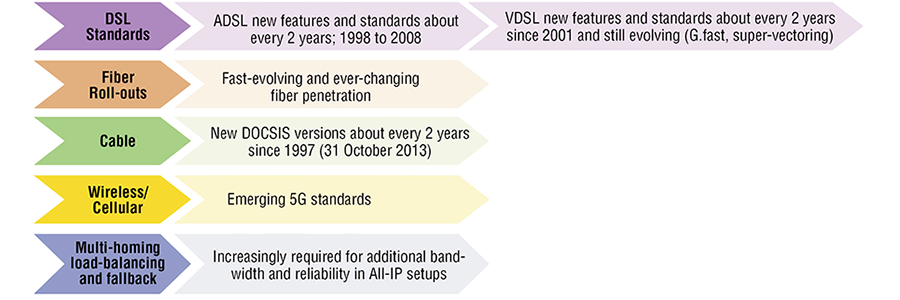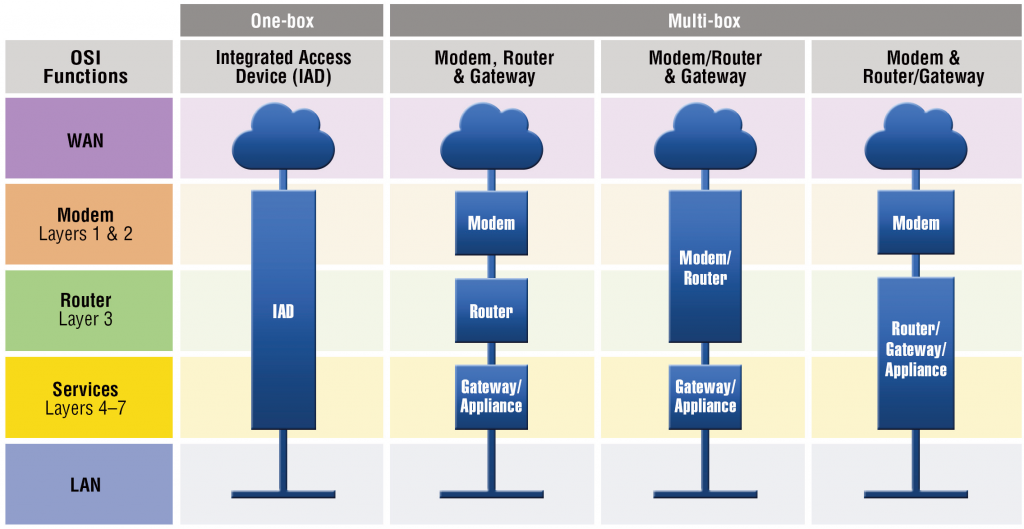CPE Architecture: When Does ALL-IP Equal All-in-One? [Part II]
In Part I, we introduced the idea that multiple factors govern the best decision about CPE architecture. Now we will dig deeper into what some of those factors are. ..
Market Segmentation—Economies of scale
First, not all customers are the same. Customarily the telecom market can be roughly segmented into three categories: residential, large enterprise, and small-to-medium enterprise (SME).
This post is Part II in a series about the tradeoffs with single-unit versus multi-unit CPE architecture. Part I introduced the various configurations for covering OSI layer functions. >>Read it here…
- Residential. The residential market is characterized by large volumes with a highly-standardized service offering. Service deployment, management, and maintenance are designed for process-oriented procedures. Chipmakers and equipment vendors have developed highly integrated and extremely cost-effective solutions that focus on these requirements. Because the large volumes justify the up-front investment, one-box solutions—that is IADs—dominate this market segment.
- Large Enterprise. On the other end of the scale, large enterprises typically have proprietary business processes that demand customized network environments. Solutions typically require a project-oriented approach with unique system designs. Solutions providers combine best-of-breed software, hardware and services to build an ALL-IP solution that satisfies the need. Commercially, equipment cost is less relevant than overall project pricing. The CPE setup may easily include four or five dedicated devices to provide such functions as transmission, routing, firewall, bandwidth-optimization, media gateway and signaling.
- SME. Between residential and large enterprise spaces, the SME market presents specific challenges.On one hand, system requirements and company sizes can vary wildly; on the other hand, there are relatively high volumes that call for process automation and standardization. For the SME environment, there are several arguments that favor a two-box or multi-box solution.

Access Technology Trends
Transmission technologies for network access—and their availability—are still rapidly evolving. This is true for wired and wireless solutions. In the SME space, asymmetric (ADSL, VDSL) and symmetric (SDSL, EFM) technologies are both relevant. On a roughly two-year cycle, improved standards emerge that increase the bandwidth capacity of legacy copper lines even further. More and more fiber deployments continue rolling out from city centers to suburbs and industrial areas. Meanwhile, wireless (4G, 5G) connections gain importance as fall-back, or even primary, Internet access links. This CPE architecture corresponds to the Modem & Router/Gateway column in figure 1.

Service providers must select which access technologies to employ in their SME offerings based on price, bandwidth, and geographic coverage. Rolling out a new access technology represents a costly, long-term infrastructure project. Service offerings, on the other hand, can evolve more rapidly. Under these circumstances, it can make sense to separate the access transmission functions (OSI layer 1 and layer 2) from the routing and service functions (layers 3 to 7), provided by two separate devices. Such an approach eliminates dependencies, increases flexibility in designing services, and expands geographic coverage.
Logistics
Let’s assume a service provider wants to offer business services for SMEs ranging from 4 to 30 voice calls with varying subscriber interfaces and over three different access networks. Let’s consider how many box types the provider must purchase, stock, manage and maintain for each approach: one-box and two-box.
Part III will cover the logistical details comparing single and multi-box CPE deployments. Plus discussion of service evolution and security concerns.
>Or you can download the full white paper here. . .
CPE Architecture: When Does All-IP Equal All-in-One?
To learn more about Patton solutions, contact the 888VoIP team at 888-864-7786 or view our Patton product offerings.
About the Author: Ramon Felder, Business Development Executive, Patton-Inalp Networks. Ramon Felder is the business development executive for Patton-Inalp Networks in Switzerland. Previously, he has served Patton-Inalp over 18 years in different roles as CEO, COO, and product manager. Mr. Felder graduated in 1996 from the Swiss Federal Institute of Technology in Lausanne and holds a Master degree in Business Administration from the University of Rochester.


